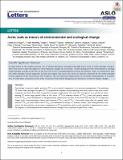Files in this item
Arctic seals as tracers of environmental and ecological change
Item metadata
| dc.contributor.author | de la Vega, Camille | |
| dc.contributor.author | Mahaffey, Claire | |
| dc.contributor.author | Tuerena, Robyn E. | |
| dc.contributor.author | Yurkowski, David J. | |
| dc.contributor.author | Ferguson, Steven H. | |
| dc.contributor.author | Stenson, Garry B. | |
| dc.contributor.author | Nordøy, Erling S. | |
| dc.contributor.author | Haug, Tore | |
| dc.contributor.author | Biuw, Martin | |
| dc.contributor.author | Smout, Sophie | |
| dc.contributor.author | Hopkins, Jo | |
| dc.contributor.author | Tagliabue, Alessandro | |
| dc.contributor.author | Jeffreys, Rachel M. | |
| dc.date.accessioned | 2020-11-23T15:30:46Z | |
| dc.date.available | 2020-11-23T15:30:46Z | |
| dc.date.issued | 2020-11-12 | |
| dc.identifier | 271336545 | |
| dc.identifier | a487684b-ec04-4146-8740-37d0898cc3d5 | |
| dc.identifier | 000592655300001 | |
| dc.identifier | 85098132645 | |
| dc.identifier.citation | de la Vega , C , Mahaffey , C , Tuerena , R E , Yurkowski , D J , Ferguson , S H , Stenson , G B , Nordøy , E S , Haug , T , Biuw , M , Smout , S , Hopkins , J , Tagliabue , A & Jeffreys , R M 2020 , ' Arctic seals as tracers of environmental and ecological change ' , Limnology and Oceanography Letters , vol. Early View . https://doi.org/10.1002/lol2.10176 | en |
| dc.identifier.issn | 2378-2242 | |
| dc.identifier.other | RIS: urn:4AFC867C20AFCA513A1610B20D9E7AB0 | |
| dc.identifier.uri | https://hdl.handle.net/10023/21049 | |
| dc.description | This work resulted from the ARISE project (NE/P006035/1, NE/P006310/1, and NE/P006000/2), part of the Changing Arctic Ocean programme, funded by the UKRI Natural Environment Research Council (NERC). | en |
| dc.description.abstract | Knowledge of species trophic position (TP) is an essential component of ecosystem management. Determining TP from stable nitrogen isotopes (δ15N) in predators requires understanding how these tracers vary across environments and how they relate to predator isotope composition. We used two seal species as a model for determining TP across large spatial scales in the Arctic. δ15N in seawater nitrate (δ15NNO3) and seal muscle amino acids (δ15NAA) were determined to independently characterize the base of the food web and the TP of harp and ringed seals, demonstrating a direct link between δ15NNO3 and δ15NAA. Our results show that the spatial variation in δ15NAA in seals reflects the δ15NNO3 end members in Pacific vs. Atlantic waters. This study provides a reference for best practice on accurate comparison of TP in predators and as such, provides a framework to assess the impact of environmental and human-induced changes on ecosystems at pan-Arctic scales. | |
| dc.format.extent | 9 | |
| dc.format.extent | 1001344 | |
| dc.language.iso | eng | |
| dc.relation.ispartof | Limnology and Oceanography Letters | en |
| dc.subject | GE Environmental Sciences | en |
| dc.subject | GC Oceanography | en |
| dc.subject | QH301 Biology | en |
| dc.subject | DAS | en |
| dc.subject.lcc | GE | en |
| dc.subject.lcc | GC | en |
| dc.subject.lcc | QH301 | en |
| dc.title | Arctic seals as tracers of environmental and ecological change | en |
| dc.type | Journal article | en |
| dc.contributor.institution | University of St Andrews. School of Biology | en |
| dc.contributor.institution | University of St Andrews. Sea Mammal Research Unit | en |
| dc.contributor.institution | University of St Andrews. Scottish Oceans Institute | en |
| dc.contributor.institution | University of St Andrews. Centre for Research into Ecological & Environmental Modelling | en |
| dc.contributor.institution | University of St Andrews. Coastal Resources Management Group | en |
| dc.identifier.doi | https://doi.org/10.1002/lol2.10176 | |
| dc.description.status | Peer reviewed | en |
This item appears in the following Collection(s)
Items in the St Andrews Research Repository are protected by copyright, with all rights reserved, unless otherwise indicated.

